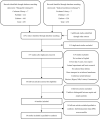Treatment of infected bone defects with the induced membrane technique
- PMID: 37697974
- PMCID: PMC10495849
- DOI: 10.1302/2046-3758.129.BJR-2022-0439.R2
Treatment of infected bone defects with the induced membrane technique
Abstract
Aims: This study aimed to evaluate the effectiveness of the induced membrane technique for treating infected bone defects, and to explore the factors that might affect patient outcomes.
Methods: A comprehensive search was performed in PubMed, Embase, and the Cochrane Central Register of Controlled Trials databases between 1 January 2000 and 31 October 2021. Studies with a minimum sample size of five patients with infected bone defects treated with the induced membrane technique were included. Factors associated with nonunion, infection recurrence, and additional procedures were identified using logistic regression analysis on individual patient data.
Results: After the screening, 44 studies were included with 1,079 patients and 1,083 segments of infected bone defects treated with the induced membrane technique. The mean defect size was 6.8 cm (0.5 to 30). After the index second stage procedure, 85% (797/942) of segments achieved union, and 92% (999/1,083) of segments achieved final healing. The multivariate analysis with data from 296 patients suggested that older age was associated with higher nonunion risk. Patients with external fixation in the second stage had a significantly higher risk of developing nonunion, increasing the need for additional procedures. The autografts harvested from the femur reamer-irrigator-aspirator increased nonunion, infection recurrence, and additional procedure rates.
Conclusion: The induced membrane technique is an effective technique for treating infected bone defects. Internal fixation during the second stage might effectively promote bone healing and reduce additional procedures without increasing infection recurrence. Future studies should standardize individual patient data prospectively to facilitate research on the affected patient outcomes.
© 2023 Author(s) et al.
Conflict of interest statement
All the authors declare that there is no conflict of interest.
Similar articles
-
The induced membrane technique for the management of long bone defects.Bone Joint J. 2020 Dec;102-B(12):1723-1734. doi: 10.1302/0301-620X.102B12.BJJ-2020-1125.R1. Bone Joint J. 2020. PMID: 33249891
-
Masquelet Reconstruction for Posttraumatic Segmental Bone Defects in the Forearm.J Hand Surg Am. 2019 Apr;44(4):342.e1-342.e8. doi: 10.1016/j.jhsa.2018.07.003. Epub 2018 Aug 23. J Hand Surg Am. 2019. PMID: 30146386
-
The induced membrane technique for the management of infected segmental bone defects.Bone Joint J. 2024 Jun 1;106-B(6):613-622. doi: 10.1302/0301-620X.106B6.BJJ-2023-1443.R1. Bone Joint J. 2024. PMID: 38821512
-
Induced membrane technique using enriched bone grafts for treatment of posttraumatic segmental long bone defects.J Orthop Traumatol. 2019 Mar 11;20(1):13. doi: 10.1186/s10195-019-0522-6. J Orthop Traumatol. 2019. PMID: 30859333 Free PMC article.
-
The Induced Membrane Technique for the Management of Segmental Tibial Defect or Nonunion: A Systematic Review and Meta-Analysis.Biomed Res Int. 2020 May 22;2020:5893642. doi: 10.1155/2020/5893642. eCollection 2020. Biomed Res Int. 2020. PMID: 32596336 Free PMC article.
Cited by
-
Infographic: Chongqing technique.Bone Joint Res. 2024 Mar 11;13(3):124-126. doi: 10.1302/2046-3758.133.BJR-2023-0358. Bone Joint Res. 2024. PMID: 38461860 Free PMC article.
-
Surgical nonunion treatment of large-sized defects of femur and tibia based on the diamond concept.Bone Jt Open. 2025 Jan 6;6(1):26-34. doi: 10.1302/2633-1462.61.BJO-2024-0096.R1. Bone Jt Open. 2025. PMID: 39756466 Free PMC article.
-
A case of damage control after polytrauma and bilateral femur fracture.Trauma Case Rep. 2024 May 17;52:101037. doi: 10.1016/j.tcr.2024.101037. eCollection 2024 Aug. Trauma Case Rep. 2024. PMID: 38883269 Free PMC article.
-
Iodine-doped TiO2 nanotube coatings: a technique for enhancing the antimicrobial properties of titanium surfaces against Staphylococcus aureus.J Orthop Surg Res. 2023 Nov 10;18(1):854. doi: 10.1186/s13018-023-04354-8. J Orthop Surg Res. 2023. PMID: 37950251 Free PMC article.
-
Engineering the bone reconstruction surgery: the case of the masquelet-induced membrane technique.Eur J Trauma Emerg Surg. 2025 Mar 18;51(1):138. doi: 10.1007/s00068-025-02815-9. Eur J Trauma Emerg Surg. 2025. PMID: 40102268 Free PMC article. Review.
References
-
- Masquelet AC, Fitoussi F, Begue T, Muller GP. Reconstruction of the long bones by the induced membrane and spongy autograft. Ann Chir Plast Esthet. 2000;45(3):346–353. - PubMed


